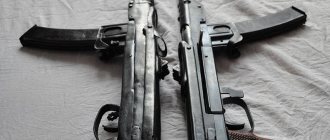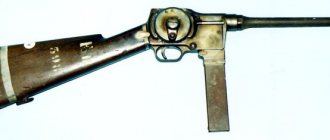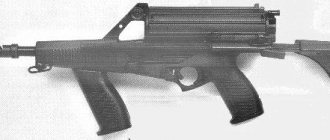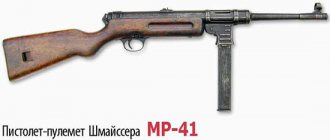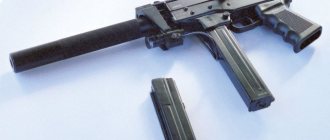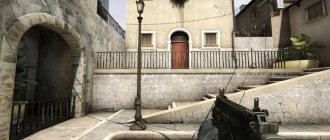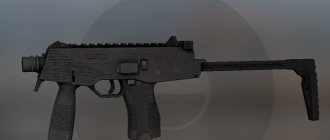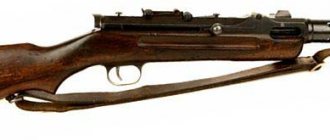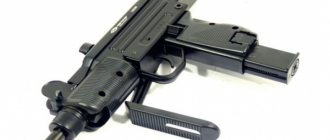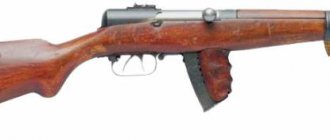History of creation
At the time of development of the PPS submachine gun, the well-proven legendary PPSh was already in service with the Red Army. But in addition to the main advantages, the famous weapon also had a number of significant disadvantages. These include considerable overall dimensions and weight, as well as relatively expensive production. Therefore, the PPSh was extremely inconvenient to use in cramped conditions of narrow trenches, by crews and paratroopers of combat vehicles, and reconnaissance detachments.
As a result of this situation, in 1942, a competition was announced for the development of a more compact, lighter, cheaper weapon to produce, which would not be inferior in performance characteristics to the Shpagin system submachine gun. Despite the participation of such famous designers as Korovin S.A., Shpagin G.S., Rukavishnikov N.V., Degtyarev V.A. in the competition, the weapon of Sudaev A.I. still won. PPS was produced at the Sestroretsk Arms Plant from 1942 to 1945.
PPS Sudaeva
This submachine gun is a weapon of the besieged Leningrad, created on the basis of the project of Sudaev and Lieutenant Technician Bezruchko-Vysotsky, who developed the return system and bolt. Experimental field tests of the new weapon took place in parts of the Leningrad Front from June 6 to June 13, 1942, as a result of which mass production of weapons began. And at the end of the same year, the submachine gun under the symbol PPS-42 was put into service.
This is interesting: along the road of life, food came to Leningrad for the residents of Leningrad, and both refugees and PPS weapons were taken back from the city.
The following year, the PPS-42 model was improved. The updated PPS-43 model was put into service in 1943.
In total, during the years of the blockade, 46,572 units of PPS weapons of both models were produced, and over 500,000 units of all PPS weapons were produced in the USSR.
In the early 50s, the PPS was withdrawn from service and gradually replaced by the Kalashnikov assault rifle. But in some units it was in service at least until the end of the 80s (militarized security).
PPD and PPSh
By 1941, the Red Army was sufficiently saturated with modern small arms. The weakest point was the submachine guns. However, one should not think that the Germans were doing better. All these myths about mass attacks by German “machine gunners” with rolled up sleeves have long been debunked. Nevertheless, for both warring armies the submachine gun was the most important article of small arms.
Scheme PPS-43
The first-born in the domestic fairly widespread PP was the famous Degtyarev submachine gun, or PPD. Oddly enough, in many ways he, and not the PPSh, became the predecessor of our today's hero, but more on that later. PPD had a lot of “childhood diseases” and was extremely expensive to produce. For example, the Degtyarev machine gun, much more complex and heavy, was more than 200 rubles more expensive, and this is unacceptable. Moreover, the imperfect design and constant improvements, as well as complaints from direct users of the PPD, did not add enthusiasm for its development as a weapon system.
PPS with standard ammunition
The PPSh - Shpagin's submachine gun - turned out to be much more successful; in many ways it became a symbol of the Great Patriotic War along with the T-34 or Il-2. But at the start of hostilities, the PPSh, which was put into service in December 1940, was only supposed to be put into mass production. The first difficult months of the war required urgent decisions regarding weapons production, and this was the proposal of Alexei Ivanovich Sudaev.
Design
The weapon has a typical design of submachine guns - it consists of a stamped steel receiver, which is connected to the barrel casing by welding and riveting, a stock, a barrel and a fire control handle. When firing, due to the rollback of the massive free shutter under the influence of recoil, the PPS automatic system operates. Shooting is carried out from the rear sear and is automatic only, there is no single mode. The shutter handle is located on the right. The recoil spring is placed on a guide rod, which is inserted into the hole at the top left of the bolt from the back side. The weapon casing at the bottom is open along the entire length of the weapon.
The weapon is equipped with a safety located in front of the trigger guard. Its operating principle is as follows: when it moves back, the trigger rod is blocked and a bar with cutouts rises, which block the cocking handle, rigidly connected to the bolt. The safety lever is moved to the firing position with the index finger forward.
The PPS sights are a front sight and a sight with a rear sight reversible into 2 fixed positions at 100 and 200 meters (indicated by numbers 10 and 20).
The PPS 42 and 43 models use 7.62×25 TT cartridges. A 35-round box magazine was inserted into the neck (receiver) and equipped with a safety clip to prevent accidental removal of the magazine. In contrast to the PPSh, the cartridges in it have a 2-row output, which increases reliability and simplifies loading the weapon.
PPS design
The Sudaev submachine gun has a folding metal stock that folds onto the receiver.
The weapon is equipped with a muzzle brake-compensator to increase the accuracy of fire.
In the PPS-43 model, the return spring is attached to the guide rod using a special stop, and the rod itself is shifted to the left and extended, and its end has become a reflector. Also in the new version of the PPS, the receiver and casing were combined; shortened the folding stock from 245 to 230 mm and the barrel from 272 to 251 mm; the cocking handle, the shoulder rest latch, the safety catch were changed, the weight of the bolt was reduced from 570 to 550 g. The butt mount was also changed. The latch head was moved to the rear above the receiver.
PPS-42 and PPS-43
The improved pistol grip allows shooting with both the butt folded and folded.
This is interesting: a submachine gun can be recreated in makeshift conditions.
PPS is lightweight - only 3.63 kg, which is more than 500 g less than PPSh.
Escapement mechanism
The PPS (automatic) has an interesting design. The release mechanism, like most of the parts, is extremely simple. It consists simply of a trigger and a lever, which are connected by an axis. A mechanism is integrated with the trigger box latch. They also have a fuse attached to them. The latch locks both boxes in the closed position. The safety device is created in the form of a plate, which is located on the right wall of the trigger box (on its inside).
This position allows you to simultaneously block the trigger mechanism, lock the connecting axis, and lock the bolt. The latter is fixed in the position in which it was when the submachine gun was put on safety. There are two positions here: front and back. In the first, the bolt is secured by the end of the safety plate, which rests against the handle on the reverse side. In the rear position, the bolt handle is secured in the middle part. Thus, a fuse is a device that is controlled by a plate. The machine itself stands on it after moving the handle down and up.
The magazine latch, which is located in front of the trigger guard, is covered with a bracket welded to the neck. It prevents you from accidentally pressing the latch, but at the same time it is intended for convenience. The PPS-43 assault rifle is very functional, its parts often perform several roles, this ensures simplicity of design, and, therefore, speeds up production. It is unlikely that you will be able to create a PPP (automatic machine) with your own hands - this requires special conditions and equipment.
Peculiarities
There are several features of this submachine gun, namely:
- simplicity of design;
- low weight and overall dimensions;
- extreme simplicity of manufacturability;
- low material costs (2 times less than PPSh) and labor costs for production (three times less than PPSh).
In addition to the above features, I would also like to highlight the fact that the weapon has good accuracy, but a lower rate of fire than the PPSh. Due to the absence of a single fire mode, its simulation can be performed by smoothly pressing and quickly releasing the trigger.
PPP Drawing
The lethal range of this weapon's bullet is 800 m, but the effective combat distance was considered to be 100-200 meters. In order to hit a single enemy at a distance of up to 100 meters when firing in short bursts, 1 cartridge was needed, up to 150 m - 2 cartridges, up to 200-250 m - 3 cartridges, 300 m - 4 cartridges.
Due to its simplicity and very high manufacturability, this submachine gun often became the basis for the creation of handicraft weapons. For example, the Georgian border crossing point Iveria.
Modifications
- PPS-42/PPS-43.
- m/44 - Finnish version of the PPS chambered for the 9x19 mm Luger cartridge.
A total of 10,400 weapons were produced. In 57-58 years of the last century, the weapon was in service with the Finnish UN peacekeeping forces in the Sinai Peninsula. - PPS wz. 1943/1952 - Polish version of the teaching staff.
- DUX 54 is a Finnish version of the PPS, which was produced in small batches in Germany and Spain.
- Type 54 - Chinese version of the PPS.
- In the DPRK, teaching staff were also issued after the war.
PPS-42
The model, which did not meet all the requirements and had flaws, needed to be corrected. A new PPS machine gun was put into mass production. The device had the best performance. Therefore, PPS-42 is quite difficult to find, few of them were produced. They are quite rare in private collections and museums. But how do the models differ? With the replaced device, the connection point of the shoulder rest with the rods is lower, the upper arm of the rest is much longer than the lower one. This is one of the main external differences; anyone can notice it, even those unfamiliar with the features of the machines of that time. However, in photographs, the part that is the distinguishing feature is often hidden by the shooter's shoulder, so it is not as well known.
Also, PPS-42 and 43 have another interesting difference: when the butt is folded, the shoulder rest in the earlier model is located in front of the sight block, while in the other it covers it. How can this be explained? In PPS-43, the length of the barrel and butt was reduced, and therefore the overall length became much shorter (from 907 to 820 mm). This also made it possible to greatly reduce the weight of the model. In addition, there are some technological changes that have increased the combat qualities of the PPS-43. However, they cannot be seen with the naked eye.
Combat use
The PPS during the Second World War was in service with the forces of the Red Army and military formations on the territory of the USSR.
PPS among Red Army soldiers
Trophy PPS were popular among Finnish units and reconnaissance formations.
The Wehrmacht, SS and other military formations also used captured PPS called Maschinenpistole 719(r).
After World War II, the PPS was in service with the Polish army, and until 1997 it was in service in the DPRK and Laos. In the early 90s, PPS was used by paramilitary security units and PPS forces in Ukraine. Weapons were also seen during the military conflict in Donbass in the hands of militias.
PPS in Donbass
Performance characteristics
| Weight, kg | with loaded (empty) magazine 3.63 (3.115) / 3.67 (3.155) |
| Length, mm | with folded (unfolded) butt 640 (910) / 616 (831) |
| Barrel length, mm | 272 / 251 |
| Cartridge | 7.62×25 mm TT |
| Caliber, mm | 7,62 |
| Work principles | blowback |
| Rate of fire, rounds/min | 700 / 600 |
| Initial bullet speed, m/s | 500 |
| Sighting range, m | 200 |
| Maximum range, m | 1500 |
| Type of ammunition | 35 round box magazine |
